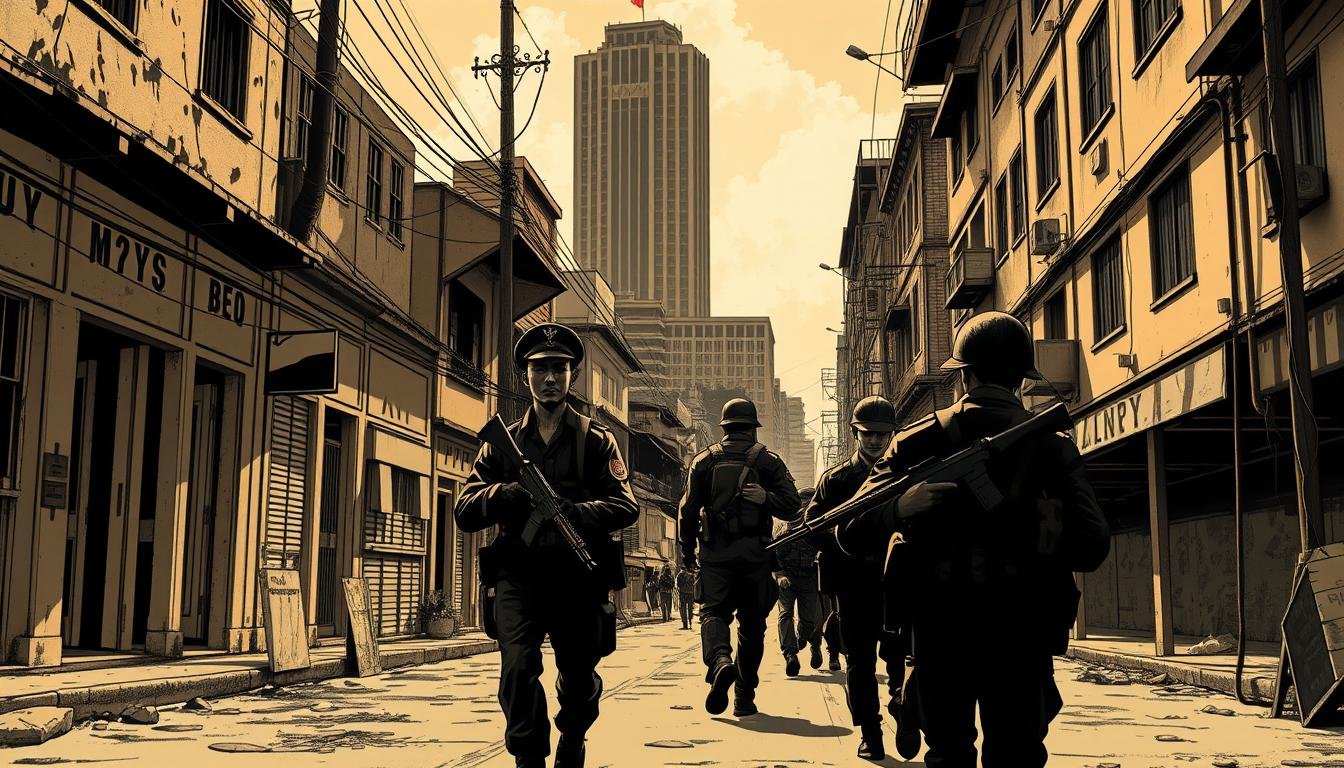During World War II, the Japanese military rule in the Philippines left a lasting mark on Filipino cities. From 1942 to 1945, urban centers like Manila experienced significant changes in infrastructure, governance, and daily life. The occupation began shortly after the attack on Pearl Harbor, bringing with it a new political and social order.
The term “rule” in this context refers to both military control and administrative governance. In Filipino cities, this meant strict regulations, resource allocation, and the establishment of new governing bodies. The Japanese introduced policies that reshaped urban planning, often prioritizing military needs over civilian welfare.
Historical records show that the occupation also led to widespread resistance. Guerrilla movements, such as the Hukbalahap, emerged to challenge Japanese authority. These efforts highlighted the resilience of the Filipino people during a turbulent period.
Key Takeaways
- Japanese military rule in the Philippines lasted from 1942 to 1945.
- Urban centers experienced significant changes in infrastructure and governance.
- The term “rule” encompassed both military control and administrative policies.
- Resistance movements like the Hukbalahap played a crucial role in opposing Japanese authority.
- The occupation left a lasting impact on Filipino cities and their development.
Introduction and Overview
From 1942 to 1945, Filipino cities underwent significant transformations under Japanese military control. This section explores the scope and objective of the article, focusing on the law and governance structures introduced during this period. It also highlights the historical relevance of these changes and their impact on urban development.
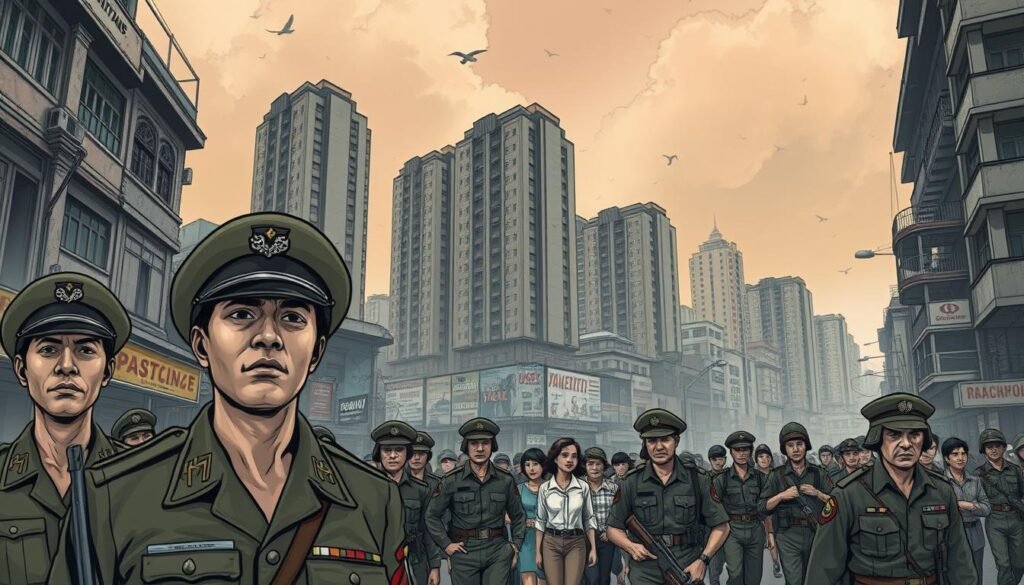
Article Scope and Objective
The primary goal of this article is to analyze the effects of Japanese military influence on Filipino cities. This includes examining the definition of governance during the occupation and how it reshaped urban planning. By understanding these changes, we can better appreciate the resilience of Filipino communities during this challenging time.
Historical Relevance and Context
During the occupation, the Japanese introduced new laws and policies that prioritized military needs over civilian welfare. These changes were enforced through strict regulations and resource allocation. Historical records show that this period also saw the rise of resistance movements, such as the Hukbalahap, which challenged Japanese authority.
The following table outlines key aspects of Japanese military governance in Filipino cities:
| Aspect | Description |
|---|---|
| Governance | New administrative bodies were established to enforce Japanese policies. |
| Urban Planning | Infrastructure projects focused on military needs, often at the expense of civilian welfare. |
| Resistance | Guerrilla movements emerged to oppose Japanese control, highlighting Filipino resilience. |
These historical events provide valuable insights into how governance and law evolved during the occupation. They also serve as a reminder of the enduring spirit of the Filipino people.
Historical Context of Japanese Military Rule
The Japanese military occupation of the Philippines reshaped the country’s urban and governmental landscape. From 1942 to 1945, the country experienced a series of regulatory and administrative changes that left a lasting impact on its cities. This period marked a significant shift in governance, as the Japanese introduced new policies to consolidate their control.
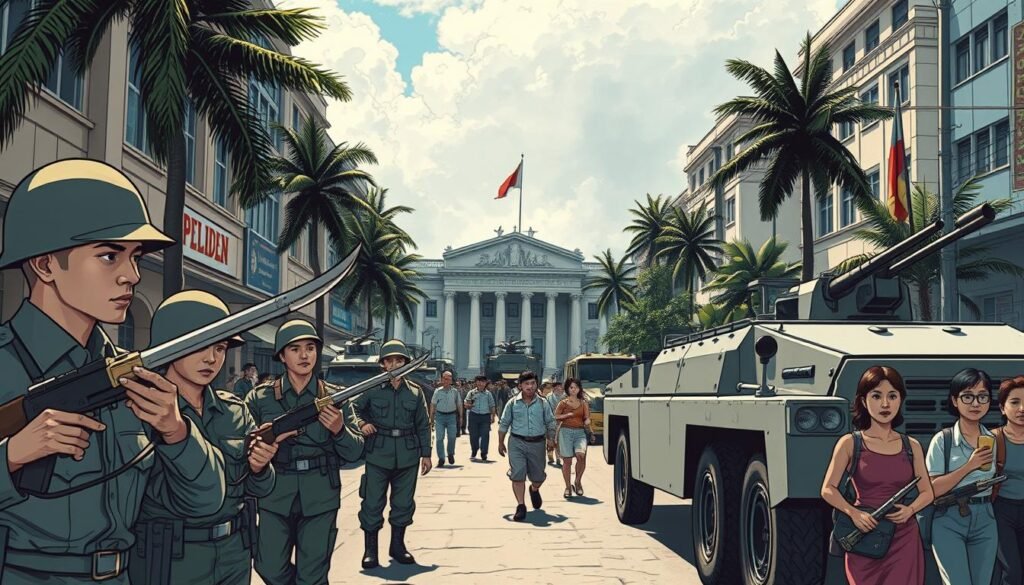
During this time, the Japanese government implemented strict regulations to manage resources and maintain order. These actions often prioritized military needs over civilian welfare, leading to widespread resistance. The rise of guerrilla movements, such as the Hukbalahap, highlighted the Filipino people’s resilience in the face of adversity.
Timeline of Key Events in the Philippines
The occupation began in 1942, shortly after the attack on Pearl Harbor. The Japanese swiftly established new administrative bodies to enforce their policies. These actions reshaped urban planning, with infrastructure projects focusing on military logistics.
One notable exception was the treatment of local leaders. While some collaborated with the Japanese, others faced severe consequences for opposing their authority. This duality created a complex social and political environment.
By 1945, the occupation ended with the liberation of the Philippines. However, its effects lingered, influencing the country’s governance and urban development for decades. The table below outlines key events during this period:
| Year | Event | Impact |
|---|---|---|
| 1942 | Japanese occupation begins | New administrative bodies established |
| 1943 | Resource allocation policies enforced | Civilian welfare compromised |
| 1944 | Guerrilla movements gain momentum | Resistance against Japanese control intensifies |
| 1945 | Liberation of the Philippines | End of Japanese military rule |
These events underscore the profound changes the Philippines underwent during the occupation. The Japanese government’s actions and regulations not only reshaped urban centers but also left a legacy that continues to influence the country today.
Glossary of Rule Terminology
Understanding the terminology of governance during the Japanese military era provides clarity on its impact on Filipino cities. This section serves as a glossary, offering key definitions and linguistic insights to better grasp the historical and political context.
Key Definitions from Historical and Political Science
Terms like “governance” and “regulation” were central to the Japanese military era. Governance refers to the systems and processes used to manage a company or school. Regulation, on the other hand, involves the rules enforced to maintain order.
Historical texts often highlight how these terms evolved during the occupation. For example, governance structures were adapted to prioritize military needs over civilian welfare. This shift reshaped urban planning and resource allocation.

Linguistic Nuances: Noun, Verb, and Regulatory Meanings
The word “rule” can function as both a noun and a verb. As a noun, it refers to a principle or directive. As a verb, it describes the act of governing or controlling. These nuances are crucial in understanding historical documents.
Regulatory language often differs from everyday usage. For instance, a company might use “rule” to describe internal policies, while a school might apply it to disciplinary measures. These distinctions highlight the flexibility of the term.
To encourage deeper exploration, readers can browse multilingual dictionaries or historical archives. These resources provide additional examples of how terminology was applied during the occupation.
| Term | Definition | Example |
|---|---|---|
| Governance | Systems and processes for managing organizations | Japanese military governance in Filipino cities |
| Regulation | Rules enforced to maintain order | Resource allocation policies during the occupation |
| Rule (Noun) | A principle or directive | Internal policies of a company |
| Rule (Verb) | The act of governing or controlling | Military control over urban planning |
By understanding these terms, readers can better appreciate the complexities of the Japanese military era. Whether applied to a school, company, or day-to-day governance, these definitions provide valuable insights.
Urban Impact and Economic Development
The Japanese military occupation brought sweeping changes to Filipino cities, altering their infrastructure and economic systems. Urban centers like Manila underwent significant transformations, driven by military priorities and resource reallocation. These shifts reshaped the physical and economic landscapes of the Philippines.
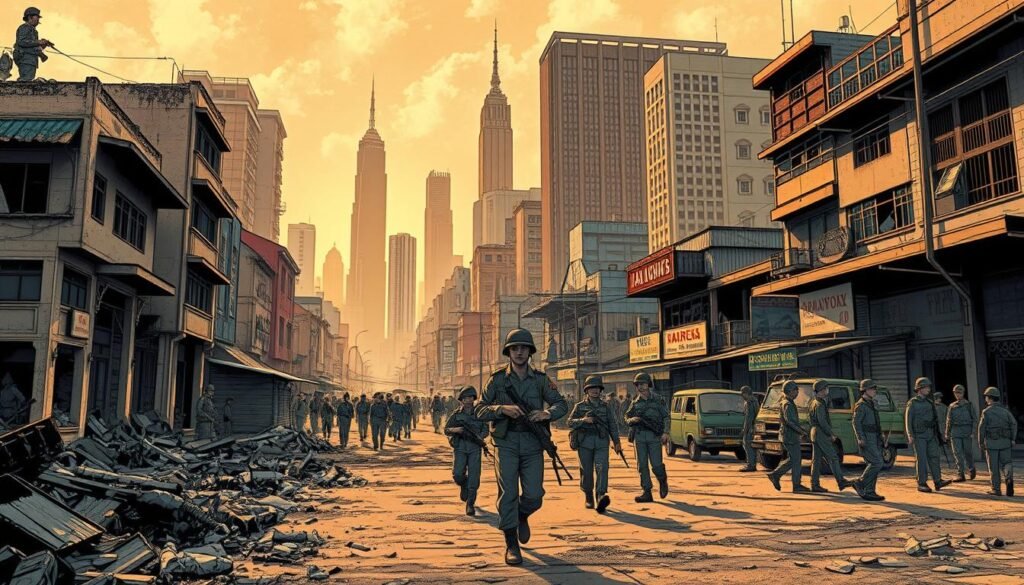
Infrastructure Transformation Under Military Influence
Under Japanese control, urban infrastructure was redesigned to support military logistics. Roads, bridges, and public buildings were repurposed or constructed to meet wartime needs. This often came at the expense of civilian welfare, as resources were diverted to military projects.
Local leaders and judges had to adapt to these changes, reassessing traditional grammar of city management. The new infrastructure allowed planners to see new possibilities, even when faced with something as complex as wartime administration.
Shifts in Urban Economic Practices
The occupation also led to significant economic changes. Commerce was reorganized to align with Japanese priorities, disrupting traditional trade networks. Urban planning strategies shifted focus from civilian needs to military efficiency.
These changes had long-term effects on Filipino cities. The table below summarizes key aspects of urban and economic transformation during the occupation:
| Aspect | Description |
|---|---|
| Infrastructure | Military-driven projects reshaped urban landscapes, often neglecting civilian needs. |
| Economic Practices | Commerce was reorganized to support Japanese military objectives. |
| Urban Planning | Strategies prioritized military logistics over civilian welfare. |
| Local Adaptation | Leaders and regulators adapted to new administrative demands. |
These transformations highlight the profound impact of Japanese military influence on Filipino cities. The changes in infrastructure and economic practices continue to shape urban development in the Philippines today.
Political and Legal Frameworks Under Military Influence
The Japanese military occupation introduced a new legal framework that reshaped governance in Filipino cities. This period saw the establishment of strict policies that prioritized military objectives over civilian needs. The transformation of governance structures and the imposition of regulations left a lasting impact on the court system and urban administration.
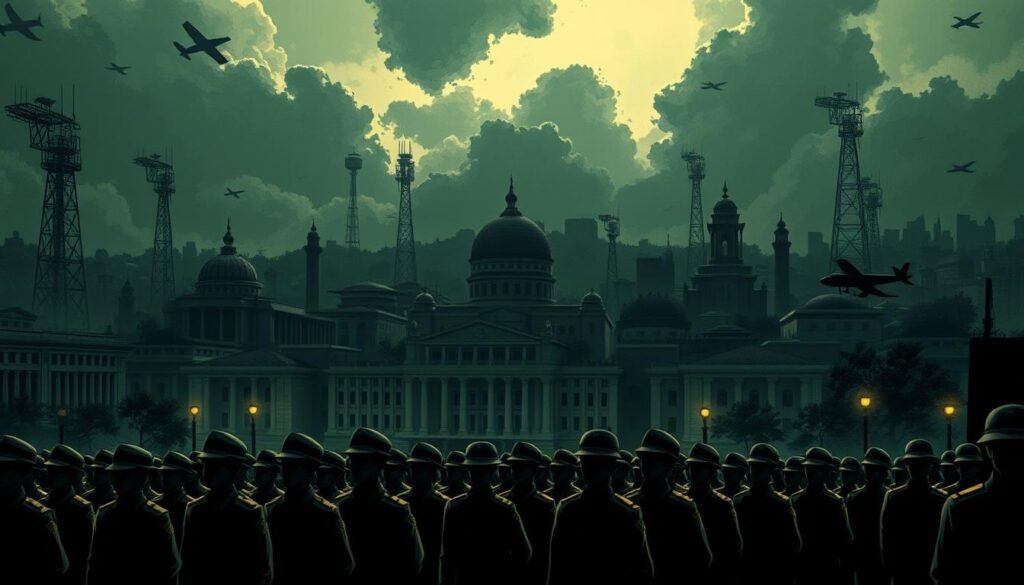
Formation of Governance Structures
Under Japanese control, governance structures were reorganized to align with military priorities. A rule book approach was implemented, standardizing procedures across institutions. This ensured that every rule thumb was followed, creating a uniform system of administration.
The court system played a crucial role in interpreting and enforcing these new regulations. Historical records show that judges had to adapt to the military’s way of operating, often prioritizing wartime needs over traditional legal principles.
Imposition and Endurance of Regulations
The occupation period was marked by stringent regulations that reshaped urban governance. These policies were designed to consolidate military control and ensure resource allocation for wartime efforts. The rule book approach extended to every aspect of administration, from infrastructure projects to civilian welfare.
Despite the challenges, the judicial system demonstrated resilience. Courts became a battleground for interpreting military rules, often finding a way to balance strict enforcement with local needs. This duality highlights the complexity of governance during the occupation.
The table below summarizes key aspects of the political and legal frameworks under Japanese military influence:
| Aspect | Description |
|---|---|
| Governance Structures | Reorganized to align with military priorities, using a rule book approach. |
| Court System | Adapted to interpret and enforce military regulations, balancing strict enforcement with local needs. |
| Regulations | Stringent policies prioritized military objectives, reshaping urban governance. |
| Rule Thumb | Standardized procedures ensured uniformity across institutions. |
These changes underscore the profound impact of Japanese military influence on Filipino cities. The legal frameworks established during this period continue to shape governance in the Philippines today. For further insights into the legal frameworks of military operations, explore this resource.
Cultural and Social Legacy in Filipino Cities
The cultural fabric of Filipino cities was deeply altered during the Japanese military occupation. This period not only reshaped governance but also left a lasting impact on community practices and traditions. From social interactions to literature, the influence of military principles continues to echo in modern Filipino culture.

Influences on Community Practices and Traditions
Under Japanese control, traditional games and social activities were reorganized to align with military priorities. These changes were guided by the principle of discipline and order, which often clashed with local customs. For example, community gatherings became more structured, reflecting the military’s emphasis on uniformity.
Literature and instructional books also played a significant role in shaping community identity. Military orders influenced the content of these materials, promoting values that supported the occupation. Despite this, Filipino authors found ways to subtly express resistance, preserving their cultural heritage.
Modern sport and cultural events in Filipino cities still bear traces of this era. The emphasis on discipline and teamwork in local games can be traced back to the military’s influence. These practices highlight the resilience of Filipino traditions, which adapted to survive under foreign control.
To learn more about the cultural evolution of the Philippines, explore this resource. For a deeper understanding of how Japanese military rule shaped social customs, visit this link.
Contemporary Perspectives on Urban Development
Modern urban development in the Philippines reflects the enduring influence of historical military strategies. The Japanese occupation introduced a framework of discipline and order that continues to shape how cities are planned and managed today. This section explores how the power dynamics of the past influence current urban practices and the role of today’s leader in integrating these lessons.
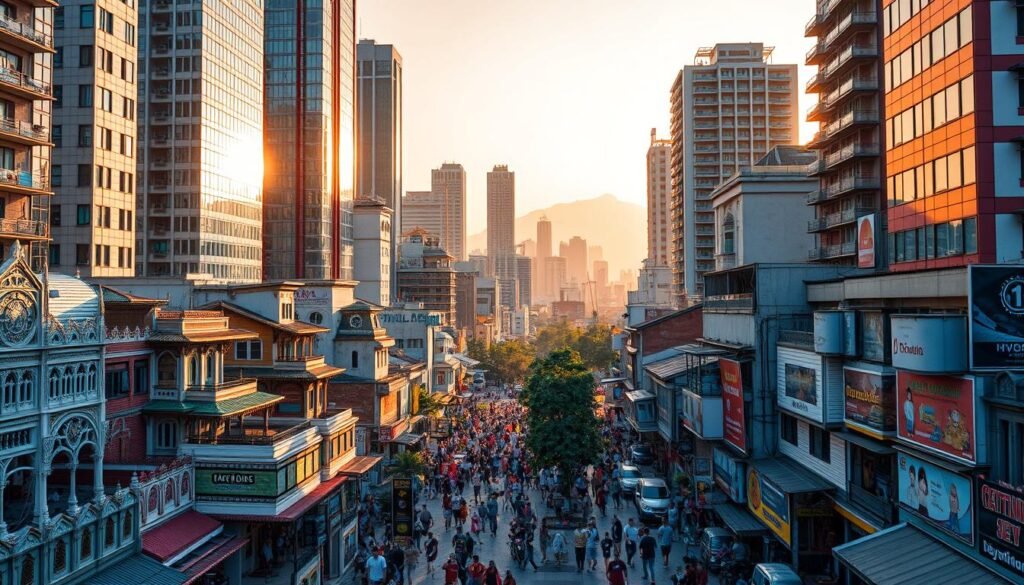
Modern Urban Planning in Historical Context
Urban planning in the Philippines today draws from the structured approaches of the Japanese military era. The emphasis on discipline and efficiency, often referred to as iron governance, has become a cornerstone of modern strategies. For example, infrastructure projects now prioritize sustainability while maintaining the rigorous standards set during the occupation.
The life cycles of cities, from growth to renewal, are managed with a focus on long-term resilience. This approach mirrors the military’s emphasis on endurance and adaptability. Urban planners often look to historical examples to guide their decisions, ensuring that cities can thrive despite challenges.
Continuing Reflections on Military Rule’s Endurance
The legacy of Japanese military governance continues to rule roost in modern urban development. The strict regulations and resource allocation practices of the past have evolved into more flexible yet structured systems. Today’s urban leader must balance historical lessons with innovative solutions to address contemporary issues.
For instance, the integration of technology in urban planning, as highlighted in this resource, reflects the enduring influence of disciplined governance. Similarly, the collaborative approaches discussed in this article emphasize the need for place-based strategies that draw from historical contexts.
Ultimately, the iron discipline of the past serves as a foundation for building smarter, more sustainable cities. By understanding the historical roots of urban development, Filipino cities can continue to grow while honoring their resilient spirit.
Conclusion
The legacy of Japanese military governance continues to shape Filipino cities, blending historical discipline with modern urban development. From infrastructure to cultural practices, the occupation set a foundation that still influences urban planning today. The structured approach of the past, often referred to as iron governance, has become a cornerstone for building resilient cities.
For the modern learner, this period offers valuable lessons in adaptability and resilience. Policymakers can draw parallels between the visionary leadership of the past and the role of a contemporary president in shaping future governance. The historical milestones of the occupation, from resource allocation to resistance movements, highlight the enduring spirit of the Filipino people.
As Filipino cities continue to grow, the lessons from this era roost in the collective memory, guiding urban development with a balance of discipline and innovation. To explore more about the historical context, visit this resource.
FAQ
What was the primary objective of Japanese military rule in the Philippines?
The main goal was to establish control over the country, integrate it into Japan’s Greater East Asia Co-Prosperity Sphere, and utilize its resources for wartime efforts.
How did Japanese military rule impact Filipino urban infrastructure?
Cities saw significant changes, including the construction of military facilities and the repurposing of existing structures for wartime needs, often disrupting local economies.
What were the key legal frameworks imposed during this period?
The Japanese introduced new governance structures, strict regulations, and martial law to maintain order and suppress resistance.
How did Japanese rule influence Filipino culture and traditions?
It left a lasting legacy on community practices, language, and social norms, blending Japanese influences with local customs.
What role did urban economic practices play under Japanese military rule?
Economic activities shifted to support wartime demands, with industries and trade heavily regulated to benefit Japanese interests.
How is modern urban planning in the Philippines connected to this historical period?
Contemporary urban development often reflects lessons learned from the infrastructure and governance changes implemented during Japanese rule.
What were the long-term effects of Japanese military rule on Filipino cities?
The period shaped urban landscapes, governance models, and cultural identities, leaving a complex legacy that continues to influence the country today.
Source Links
- Japanese occupation of the Philippines
- Historical Documents – Office of the Historian
- How to Write an Introduction
- 1 Introduction and Overview | Policing to Promote the Rule of Law and Protect the Population: An Evidence-Based Approach
- Japan – Militarism, Imperialism, WWII | Britannica
- Japan – Expansionism, Imperialism, Militarism | Britannica
- Military history of Japan
- Glossary of Legal Terms – Killino Firm
- Glossary | The Judicial Learning Center
- The impact of economic development on urban livability: Evidence from 40 large and medium-sized cities of China – Journal of Geographical Sciences
- Urban concentration and economic growth
- Urban land expansion: the role of population and economic growth for 300+ cities – npj Urban Sustainability
- Military rule | Political Regimes & Human Rights Impacts | Britannica
- Philippines – Spanish Colonization, Culture, Trade | Britannica
- Street and Trade: A Look on Culture and City Formation of Intramuros
- A New Perspective for Urban Development Boundary Delineation Based on the MCR Model and CA-Markov Model
- Human Development and Urbanism
- Conclusions | Harvard College Writing Center
- What is The IRAC Method – Everything You Need to Know
- Conclusion – Rule of Law Dynamics

